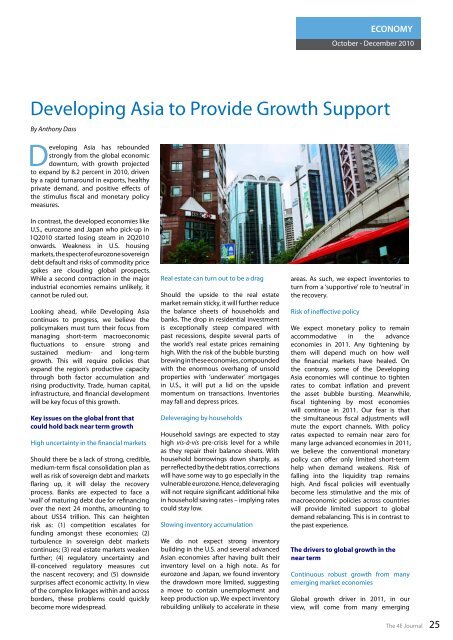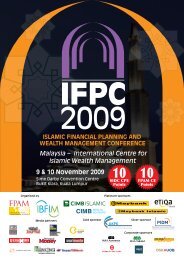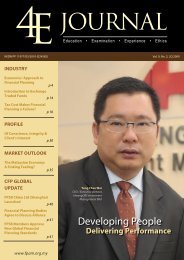Vol 10, No 4 - Financial Planning Association of Malaysia
Vol 10, No 4 - Financial Planning Association of Malaysia
Vol 10, No 4 - Financial Planning Association of Malaysia
You also want an ePaper? Increase the reach of your titles
YUMPU automatically turns print PDFs into web optimized ePapers that Google loves.
ECONOMY<br />
October - December 20<strong>10</strong><br />
Developing Asia to Provide Growth Support<br />
By Anthony Dass<br />
Developing Asia has rebounded<br />
strongly from the global economic<br />
downturn, with growth projected<br />
to expand by 8.2 percent in 20<strong>10</strong>, driven<br />
by a rapid turnaround in exports, healthy<br />
private demand, and positive effects <strong>of</strong><br />
the stimulus fiscal and monetary policy<br />
measures.<br />
In contrast, the developed economies like<br />
U.S., eurozone and Japan who pick-up in<br />
1Q20<strong>10</strong> started losing steam in 2Q20<strong>10</strong><br />
onwards. Weakness in U.S. housing<br />
markets, the specter <strong>of</strong> eurozone sovereign<br />
debt default and risks <strong>of</strong> commodity price<br />
spikes are clouding global prospects.<br />
While a second contraction in the major<br />
industrial economies remains unlikely, it<br />
cannot be ruled out.<br />
Looking ahead, while Developing Asia<br />
continues to progress, we believe the<br />
policymakers must turn their focus from<br />
managing short-term macroeconomic<br />
fluctuations to ensure strong and<br />
sustained medium- and long-term<br />
growth. This will require policies that<br />
expand the region’s productive capacity<br />
through both factor accumulation and<br />
rising productivity. Trade, human capital,<br />
infrastructure, and financial development<br />
will be key focus <strong>of</strong> this growth.<br />
Key issues on the global front that<br />
could hold back near term growth<br />
High uncertainty in the financial markets<br />
Should there be a lack <strong>of</strong> strong, credible,<br />
medium-term fiscal consolidation plan as<br />
well as risk <strong>of</strong> sovereign debt and markets<br />
flaring up, it will delay the recovery<br />
process. Banks are expected to face a<br />
‘wall’ <strong>of</strong> maturing debt due for refinancing<br />
over the next 24 months, amounting to<br />
about US$4 trillion. This can heighten<br />
risk as: (1) competition escalates for<br />
funding amongst these economies; (2)<br />
turbulence in sovereign debt markets<br />
continues; (3) real estate markets weaken<br />
further; (4) regulatory uncertainty and<br />
ill-conceived regulatory measures cut<br />
the nascent recovery; and (5) downside<br />
surprises affect economic activity. In view<br />
<strong>of</strong> the complex linkages within and across<br />
borders, these problems could quickly<br />
become more widespread.<br />
Real estate can turn out to be a drag<br />
Should the upside to the real estate<br />
market remain sticky, it will further reduce<br />
the balance sheets <strong>of</strong> households and<br />
banks. The drop in residential investment<br />
is exceptionally steep compared with<br />
past recessions, despite several parts <strong>of</strong><br />
the world’s real estate prices remaining<br />
high. With the risk <strong>of</strong> the bubble bursting<br />
brewing in these economies, compounded<br />
with the enormous overhang <strong>of</strong> unsold<br />
properties with ‘underwater’ mortgages<br />
in U.S., it will put a lid on the upside<br />
momentum on transactions. Inventories<br />
may fall and depress prices.<br />
Deleveraging by households<br />
Household savings are expected to stay<br />
high vis-à-vis pre-crisis level for a while<br />
as they repair their balance sheets. With<br />
household borrowings down sharply, as<br />
per reflected by the debt ratios, corrections<br />
will have some way to go especially in the<br />
vulnerable eurozone. Hence, deleveraging<br />
will not require significant additional hike<br />
in household saving rates – implying rates<br />
could stay low.<br />
Slowing inventory accumulation<br />
We do not expect strong inventory<br />
building in the U.S. and several advanced<br />
Asian economies after having built their<br />
inventory level on a high note. As for<br />
eurozone and Japan, we found inventory<br />
the drawdown more limited, suggesting<br />
a move to contain unemployment and<br />
keep production up. We expect inventory<br />
rebuilding unlikely to accelerate in these<br />
areas. As such, we expect inventories to<br />
turn from a ‘supportive’ role to ‘neutral’ in<br />
the recovery.<br />
Risk <strong>of</strong> ineffective policy<br />
We expect monetary policy to remain<br />
accommodative in the advance<br />
economies in 2011. Any tightening by<br />
them will depend much on how well<br />
the financial markets have healed. On<br />
the contrary, some <strong>of</strong> the Developing<br />
Asia economies will continue to tighten<br />
rates to combat inflation and prevent<br />
the asset bubble bursting. Meanwhile,<br />
fiscal tightening by most economies<br />
will continue in 2011. Our fear is that<br />
the simultaneous fiscal adjustments will<br />
mute the export channels. With policy<br />
rates expected to remain near zero for<br />
many large advanced economies in 2011,<br />
we believe the conventional monetary<br />
policy can <strong>of</strong>fer only limited short-term<br />
help when demand weakens. Risk <strong>of</strong><br />
falling into the liquidity trap remains<br />
high. And fiscal policies will eventually<br />
become less stimulative and the mix <strong>of</strong><br />
macroeconomic policies across countries<br />
will provide limited support to global<br />
demand rebalancing. This is in contrast to<br />
the past experience.<br />
The drivers to global growth in the<br />
near term<br />
Continuous robust growth from many<br />
emerging market economies<br />
Global growth driver in 2011, in our<br />
view, will come from many emerging<br />
The 4E Journal 25

















